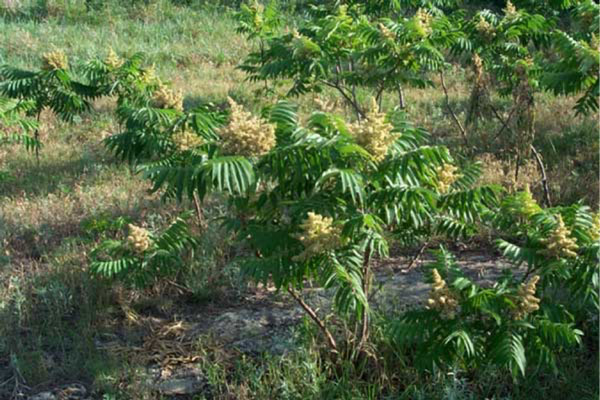Three common brush species native to Kansas and widely spread across the state are buckbrush (Symphoricarpos orbiculatus), roughleaf dogwood (Cornus drummondii), and smooth sumac (Rhus glabra).
Buckbrush is a shrub that can grow to over 6 feet tall with rhizomes and stolons. It has simple opposite leaves. Flowering occurs in June-July with red fruit produced in the late summer. Buckbrush occurs in disturbed woodlands, along creek banks, old fields, and on rangelands and pastures.
Roughleaf dogwood is a shrub that can reach 15 feet in height. Flat-topped clusters of white flowers usually appear in late May to early June. The round white fruits appear from September to October. Roughleaf dogwood occurs in fencerows, along the edges of woods, along streams, and on open prairies. It provides cover for wildlife and nesting birds.
Smooth sumac will grow to a height of 5-7 feet and produces an open milo-like head in early June. Leaves are odd-pinnately compound and turn bright red in the fall. The round red fruits are produced from August to September. It grows on rocky soils in pastures and along fencerows. Some birds will eat the seed, and the plants provide cover for birds and mammals.
These shrubs can produce clumps that will shade out and reduce forage production. Cattle generally do not browse these species. Sheep and goats are more likely to utilize these woody plants.
Be on the lookout for buckbrush, roughleaf dogwood, and smooth sumac, and implement a control plan if needed.
Buckbrush control
For effective control of buckbrush, consider top removal after the plants have leafed out and the nonstructural carbohydrates stored in the roots are at a low level. A single mowing is likely to cause resprouting, so multiple cuttings at the appropriate time (generally early to mid-May) are necessary. Another effective method is prescribed burning for 2-3 consecutive years.
Herbicides can also be used to control buckbrush. The best time to spray occurs after the plants are fully leafed out (Figure 1), but before the leaves are too mature (generally mid-May to early June). A number of herbicides can be used, but 2,4-D low-volatile ester formulations at 1.5 to 2 lbs/acre are usually quite effective. Chaparral can be used alone at 3 oz/acre, but I prefer adding 2 pint/acre 2,4-D to 2 oz/acre Chaparral. Grazon P+D can also provide acceptable control. Caution should be used if treating cool-season grasses with Chaparral. Grazon P+D is a restricted-use pesticide. Always read the label when considering the use of herbicides.

Figure 1. Buckbrush. Photo by Walt Fick, K-State Research & Extension.
Roughleaf dogwood control
Roughleaf dogwood is rarely grazed and invades grassland in the absence of prescribed burning. Pastures that are frequently burned usually do not have a roughleaf dogwood problem. A Konza Prairie study near Manhattan indicated that roughleaf dogwood increases dramatically on grazed or ungrazed watersheds with a burning frequency of 4 years compared to annual burning. Once established, roughleaf dogwood is difficult to remove with fire alone as the plant usually leafs out after the burning season. Long-term late-spring burning may gradually reduce stands of roughleaf dogwood.
The optimum time to spray roughleaf dogwood is between the flower bud state and early seed production (Figure 2). A number of foliar-applied herbicides, including triclopyr (Remedy Ultra), dicamba (Banvel), and picloram (Tordon 22K) used alone or in combination with 2,4-D will defoliate roughleaf dogwood, but actual mortality is usually less than 25%.
Roughleaf dogwood can be difficult to control. High-volume treatments providing greater than 50% mortality include 0.5-1% PastureGard HL (triclopyr + fluroxypyr), 1% Surmount (picloram + fluroxypyr), and 1% Grazon P+D + 0.5% Remedy Ultra (picloram + 2,4-D + triclopyr). All these herbicides are applied with water. Adding a 0.25 to 0.5% v/v non-ionic surfactant may enhance control. Aerial applications should be applied to at least 3 gallons per acre of total spray solution to ensure adequate coverage.
A single application of any herbicide does not completely eliminate roughleaf dogwood but may open up the stand enough to carry a fire. In subsequent years, a combination of prescribed burning in the late spring followed by a herbicide application 4-6 weeks post-burning should provide good control.

Figure 2. Roughleaf dogwood in full bloom. Photo by Walt Fick, K-State Research & Extension
Smooth sumac control
Late-spring burning will keep smooth sumac shorter in stature, but generally increases stem density. The optimum time to spray smooth sumac is between the flower bud stage and early seed production (Figure 3). Smooth sumac is among the easiest woody plants to control with herbicides if applied at the proper time. With ground or aerial applications, smooth sumac is controlled with 2-3 pint/acre 2,4-D.

Figure 3. Smooth sumac in early seed production stage. Photo by Walt Fick, K-State Research & Extension
Measures that can mitigate control of buckbrush, roughleaf dogwood and smooth sumac
Soil-applied materials such as Spike 20P (tebuthiuron) and Pronone Power Pellets (hexazinone) can provide control of roughleaf dogwood and smooth sumac. Buckbrush is not listed on the Pronone Power Pellets label. Spike 20P should be applied during the dormant season at 0.75 ounces per 100 square feet of product. This is equivalent to 20 pounds of product per acre. Pronone Power Pellets should be applied when the soil is moist and rainfall is expected within 2 weeks of application. For plants 3-6 feet tall apply 2-4 pellets at the base of the plant. Expect to see grass damage following the use of Pronone Power Pellets. These dry soil-applied products may be useful in areas where spray drift may cause considerable non-target damage.
Growing season burns, e.g. in August, have the potential to reduce stands of roughleaf dogwood and smooth sumac.
Walt Fick, Rangeland Management Specialist
whfick@ksu.edu
Tags: brush control smooth sumac buckbrush roughleaf dogwood